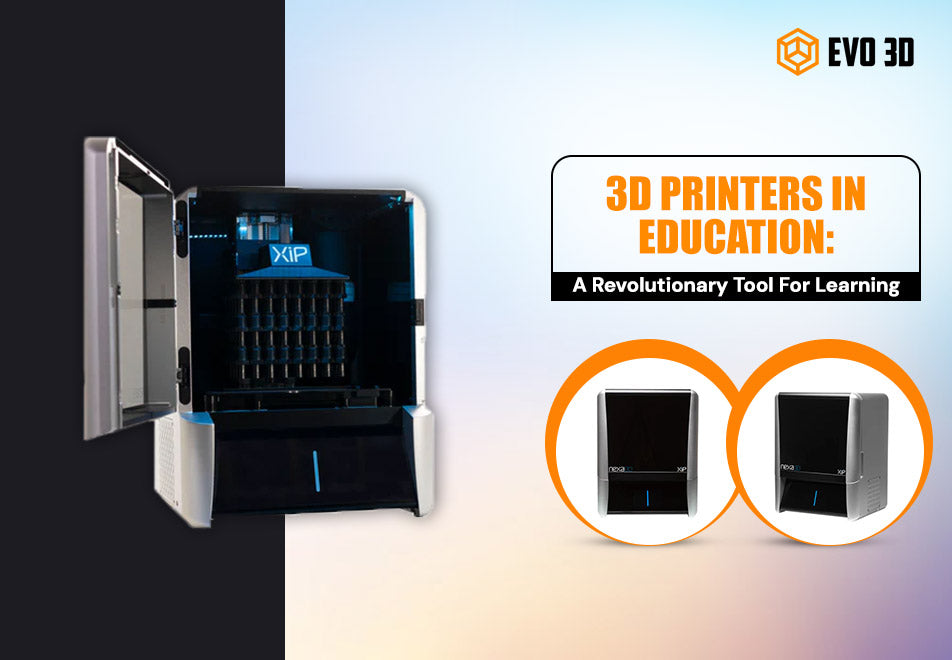3D Printers in Education: A Revolutionary Tool for Learning

3D printing technology has increased significantly in the previous years and has changed several industries including manufacturing, healthcare, and design. One of the uses of 3D printers is in education. These incredible devices enable learners of every age to interact with education in a more creative, effective, and social way.
● High Resolution and Accuracy: SLA printers fabricate objects with amazing details and precision as such, can be multi-purposed to cater to different educational activities in engineering and design or even biology and chemistry.
● Variety of Materials: SLA printers support the application of several types of resins including transparent resins, flexible resins, and biocompatible ones among others. This diversity permits the students to take risks on the materials and develop models that best depict the real thing.
● Fast Printing Speeds: SLA printers are not the fastest among the 3D printers available in the market today, however, a reasonable speed of printing is observed in SLA printers making it entirely appropriate for use in classrooms.
● Ease of Use: Most of today’s SLA printers are developed to be simple in operation, and equipped with straightforward software and instructions that are easy to follow. It suits students of all ages and skill levels.
STEM Education: 3d printers serve as an effective mechanism when it comes to understanding the concepts of science, Technology, Engineering and Mathematics (STEM). Learners can come up with and develop models of designs that are quite complex, test the use of a variety of materials, and apply engineering concepts practically.
Art and Design: Art pieces can also be created utilizing 3D printing technology. Designs can be given life through the use of various concepts and combinations of shapes, textures, and colors.
History and Archaeology: Thanks to 3D printers, one can recreate historical objects and archeological artifacts, which helps students to grasp history more vividly.
Medical Education: Medical students can make use of 3D-printed anatomical models which allow them to explore human anatomy minutely.
Product Design: 3D printers are amazing for producing 3D printers.
● Enhanced Learning: 3D printing is an active and interesting method of learning and education, which assists in the development of students' critical thinking, problem-solving, and creativity.
● Increased Engagement: When students can utilize technology to construct real physical items, they tend to be more enthralled by their studies and willing to work hard to complete them.
● Collaboration and Teamwork: They state, for example, that 3d projects extend beyond the traditional construct of individuals engaging in solo creative pursuits because they include cooperation and entail collective work that contributes to the students’ intra and inter-personal skills development.
● Real-World Applications: When 3D printers become a part of the curriculum, it allows students to apply a real-life context that is both more interesting and useful.
● Cost: 3D printing can be costly, especially for schools with fewer resources. However, the number of lower-priced alternatives continues to grow.
● Safety: Like with every technology, 3D printing entails the use of certain materials or substances that can be dangerous if abused. It is essential to take safety measures and train the students in the proper use of the equipment.
● Maintenance: To function properly, 3D printers must be regularly serviced and maintained as needed. Schools may, however, need to budget for the maintenance provided.
Understanding 3D Printing
3D printing or additive manufacturing is the construction of three-dimensional geometries by depositing layers on a layer in a bid to fabricate a shape. A 3D printer is a machine that has the accuracy and prowess to generate different three-dimensional prints. Stereolithography (SLA) 3D printer is one of the leading models preferred in schools.SLA 3D Printers: A Perfect Fit for Education
SLA 3D printers use laser light to solidify resin for successive layers to form exact objects. These kinds of 3D Printers have educational relevance due to the following reasons:-● High Resolution and Accuracy: SLA printers fabricate objects with amazing details and precision as such, can be multi-purposed to cater to different educational activities in engineering and design or even biology and chemistry.
● Variety of Materials: SLA printers support the application of several types of resins including transparent resins, flexible resins, and biocompatible ones among others. This diversity permits the students to take risks on the materials and develop models that best depict the real thing.
● Fast Printing Speeds: SLA printers are not the fastest among the 3D printers available in the market today, however, a reasonable speed of printing is observed in SLA printers making it entirely appropriate for use in classrooms.
● Ease of Use: Most of today’s SLA printers are developed to be simple in operation, and equipped with straightforward software and instructions that are easy to follow. It suits students of all ages and skill levels.
What are the Educational Applications of 3D Printers?
3D printers are worth using at all levels of education Here are some ideas on how such machines can be of great assistance in the process of studying:STEM Education: 3d printers serve as an effective mechanism when it comes to understanding the concepts of science, Technology, Engineering and Mathematics (STEM). Learners can come up with and develop models of designs that are quite complex, test the use of a variety of materials, and apply engineering concepts practically.
Art and Design: Art pieces can also be created utilizing 3D printing technology. Designs can be given life through the use of various concepts and combinations of shapes, textures, and colors.
History and Archaeology: Thanks to 3D printers, one can recreate historical objects and archeological artifacts, which helps students to grasp history more vividly.
Medical Education: Medical students can make use of 3D-printed anatomical models which allow them to explore human anatomy minutely.
Product Design: 3D printers are amazing for producing 3D printers.
What are The Benefits of 3D Printing?
The benefits of 3D printers in education are new and include:● Enhanced Learning: 3D printing is an active and interesting method of learning and education, which assists in the development of students' critical thinking, problem-solving, and creativity.
● Increased Engagement: When students can utilize technology to construct real physical items, they tend to be more enthralled by their studies and willing to work hard to complete them.
● Collaboration and Teamwork: They state, for example, that 3d projects extend beyond the traditional construct of individuals engaging in solo creative pursuits because they include cooperation and entail collective work that contributes to the students’ intra and inter-personal skills development.
● Real-World Applications: When 3D printers become a part of the curriculum, it allows students to apply a real-life context that is both more interesting and useful.
Challenges and Considerations
There are several advantages of using the 3D printing technique, but there are also several challenges and factors to consider:● Cost: 3D printing can be costly, especially for schools with fewer resources. However, the number of lower-priced alternatives continues to grow.
● Safety: Like with every technology, 3D printing entails the use of certain materials or substances that can be dangerous if abused. It is essential to take safety measures and train the students in the proper use of the equipment.
● Maintenance: To function properly, 3D printers must be regularly serviced and maintained as needed. Schools may, however, need to budget for the maintenance provided.
